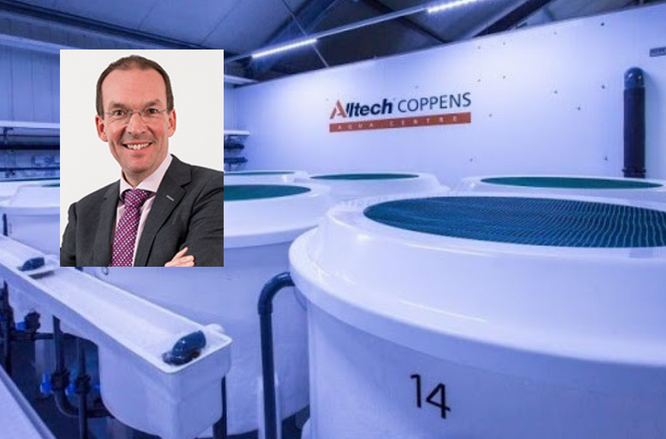“There are several things that are important for a good RAS-feed”, says Alltech Coppens Gijs Rutjes Technical Sales Support Manager. “And one must always keep in mind that it is both the fish and the biofilter that is fed.”
Talking to SalmonBusiness, Rutjes explained that RAS feed should not only satisfy the nutritional needs of fish but also that the physical properties should also minimize water contamination. “Feed pellets and faeces from the fish must be firm so that they do not dissolve in the water and can be effectively removed by the mechanical filter. An easy way to check this yourself is to use a hoof in the drain,” explained Gijs.

“Feed pellets need to be firm and durable so that they can withstand the friction they are exposed to in feeding and transportation systems. This is essential so that dust generation can be minimized. Fish cannot consume dust, it will pollute the water and possibly contaminate the gills,” said Gijs. Sinking speed is also important, he added. “The pellet should sink slowly so that all individual fish in the tank have enough time to eat the pellets. This helps to evenly distribute the pellets to the whole batch of fish and minimizes uneaten pellets.”

Management and competence
Good knowledge of the management practices and feeding routines are fundamental to the success of both your fish and your farm, explained Rutjes. “It is important to have very good day-to-day stock control and adequate feed rates. In general, a feed rate near satiation works best for most species as it allows high performance without the risk of overfeeding. One should bear in mind that even small amounts of uneaten feed, usually of a high nutrient density, will pollute the water and lower the water quality. Only if optimal water quality is maintained the fish and the system can perform well,” he said.

Production of RAS-feed- “fine tuning” of raw materials
A good RAS-feed must be easily digestible and tasty, and the choice of raw materials is crucial.
Alltech Coppens performs taste and digestion tests on all ingredients in its own research centre, Alltech Coppens Aqua Centre (ACAC).
Alltech Coppens Aqua Centre (ACAC)
“We only work with stable feed formulations,” said Gijs, which means “that there will not be a big variation in ingredients from batch to batch.” The feed intake “does not drop due to new feed delivery and more important the bacteria in the bio-filter do not have to adapt to the “new” feed. If feed varies too much, bacteria are disturbed resulting in fluctuating water quality for days, if not weeks.”
Alltech Coppens has documented this several times.

The principle of protein saving
“We work from the principle of protein saving,” said Gijs. In most cases, this leads to a reduction of TAN up to 30%.
“Growth is of course important, and the fish must be provided with nutrients that meet their requirements at a high growth rate. Obtaining higher growth rate and a low FCR is also about selecting the right ratio between digestible protein and digestible energy (DP/DE) for a given weight range. In most cases the change in body composition, as the fish grows, demands a change in the DP/DE profile for each pellet size. We call it “The principle of protein saving”, says Gijs, whereby the supply of dietary protein is sufficient but not more than that required for fast growth.
He explained that “the metabolism of fish will automatically save protein for growth and utilizing dietary fat and carbohydrates for energy. In this way, the highest protein retention can be reached at every growth phase. A higher protein retention means that a lower amount of ammonium-nitrogen (TAN) is produced per kg of feed. A TAN reduction of up to 30% can often be reached per kg of feed with the same performance by optimizing the DP/DE. This is quite interesting as it allows for a higher feed load on the system filters, thereby creating a better water quality and higher productivity. Some trout RAS farms have seen significant improvements with our salmon and trout feed.”
Inorganic minerals, a challenge for the environment
“By meticulously selecting feed ingredients, it is also possible to reduce the environmental footprint,” Gijs said. “Essential minerals that are chelated to organic molecules have been found to be more bioavailable to the fish. This will result in greater absorption levels and reduced mineral levels in feed. We call it “Total Replacement Technology (TRT),”” he said.
Alltech Coppens uses only chelated organic minerals in its feed. Recent trials have shown that removal of inorganic minerals from fish diets have resulted in increased performance and health. Organic minerals do not have the same pro-oxidative effects as inorganic minerals, therefore do not react with vitamins, astaxanthin and essential enzymes. One example we have seen is a better pigmentation of the fish fillet.

“By using TRT we reduce the environment impact, says Gijs. Many fish farmers are surprised when high values of minerals in sludge are reported,” he added
Gut Health – Management Program
It is important to consider the role of intestinal health when producing healthier and more robust fish, thinks Rutjes. “The intestine contains a large part of the animal’s immune system, and this is where the nutrients are absorbed, and it is in the intestine the microflora lives. Good intestinal health is an integral part of the Alltech Coppens` Gut Health Management Program. Aquate is a yeast-based additive developed by Alltech, leading animal health nutrition company, designed to support intestinal health and maximize growth performance.”
Research is the basis for all the products
Rutjes concluded that “careful assessment of feed ingredients, minerals and vitamins, as well as fine-tuning of raw materials lead to a feed that is perfect for the fish and the RAS system. The results and benefits in salmon are not only seen on land but from the transfer to the sea right through to harvest.”

